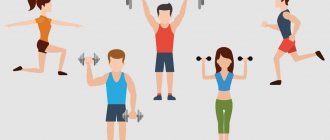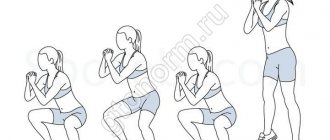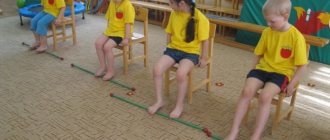A coin twisted on a table clearly demonstrates that you can spin for a very long time if you don’t hunch over and don’t distort the position of your axis. But the dancer’s body is not a hammered piece of metal, so it constantly strives to make contortions to maintain balance. The result is that we lose our balance, and as a result, not a single clean pirouette. In a pirouette, the axis created by your own body is paramount; rotation is built around it. Several clean pirouettes are only possible with excellent alignment.
So how can you teach yourself to build the axis correctly? What secrets does pirouette hide? This will be discussed below, most of this article will focus on alignment and the secrets to maintaining position while rotating.
To develop stability, you need to resort to these exercises. They will help you develop aplomb, and with it, correctly use force and pushing power. The success of the pirouette depends on them!
What does it take to do a handstand?
Handstands don't require you to spend six hours a week in the gym, but physical fitness is still important. There are several criteria by which you can evaluate yourself.
Strong shoulders
If you can do at least five pull-ups or ten push-ups, you have strong enough shoulders and arms to do a handstand and even walk a few steps. Here are some exercises for pumping up your shoulders in the gym.
Flexible wrists
Try this test: Extend your arms in front of you, bend your wrists and point your palms with your fingers towards each other. If your wrist angle is 90 degrees or so, you have plenty of joint mobility. For people with limited wrist mobility, it is best to first stretch and strengthen them.
Core muscles and balance
Core strength is directly related to the ability to maintain balance. Try the following asana. Stand straight with your feet together. Bend your body parallel to the floor, lift your leg and extend your arms forward so that your leg and arms are parallel to the floor. Stay in this position for 30 seconds. If you succeed, it means that your core muscles are strong enough. If not, exercises to develop them will help you.
If everything is in order, you can move on to training. The first thing to do is warm up.
An “arms up” exercise that tightens the stomach and arms. How to do it correctly?
Office work and a sedentary lifestyle have a negative impact not only on posture, but also on health in general. Yoga, special sets of exercises, massage can come to the rescue - the choice is quite large. However, there is a simpler but more effective way to get rid of neck and back pain, tighten your stomach and improve your posture. The “hands up” exercise, which is easy to perform, can be done literally anywhere - in the morning, before getting out of bed, in the afternoon, sitting at your desk, or in the evening while standing.
The crocodile exercise will help you tighten your stomach and achieve a thin waist.
One of the most effective fitness lifehacks for a chiseled figure.
Benefits of exercise
This exercise, although it seems completely uncomplicated, is quite effective. It has a positive effect on the health of the neck, shoulders and back, and also helps reduce waist size.
Photo: istockphoto.com
In addition, the “hands up” exercise helps:
- relieve swelling from the shoulders;
- improve posture;
- make your arms and shoulders stronger;
- reduce back pain;
- develop a sense of balance;
- get rid of weakness in the back and legs and, as a result, improve blood circulation;
- speed up digestion.
Features of the exercise
Often, when sitting at a computer or office desk, many people hunch over, lower their shoulders forward and tilt their heads. In this position, the load on the spine increases significantly, and the muscles of the neck and shoulders become numb, remaining in one position for a long time.
Photo: istockphoto.com
In addition, due to incorrect back position, intervertebral discs can wear out or pinch nerves over time, which ultimately leads to discomfort and back pain.
By raising our hands up, we seem to straighten the spine, stretch the intervertebral discs and knead the stiff muscles of the cervical-shoulder region. Also, exercise helps straighten the digestive tract, which promotes faster digestion of food and has a positive effect on metabolism.
Three simple exercises for lower back pain that will make life easier
To prevent back muscles from stagnating, it is enough to devote at least a few minutes a day to exercise.
Execution technique
You can do the exercise in three positions: lying, sitting and standing.
Lying in bed
Photo: istockphoto.com
As you inhale, extend your arms above your head and stretch well, tensing your entire body from your toes to your toes. Feel the muscles stretch and straighten. As you exhale, slowly lower your arms along your body and relax.
Sitting on a chair
Photo: istockphoto.com
Straighten your back and press it against the back of the chair. As you inhale, stretch upward, raising your arms as high as possible and stretching your chin. In this case, the abdominal wall should be tense. As you exhale, also lower your arms and relax your muscles.
standing
Photo: istockphoto.com
Stand straight with your feet together. As you inhale, raise your arms, clasp your fingers and stretch upward. You need to stretch your whole body - feel how your spine, neck straightens, and your shoulders rise. As you exhale, gently lower your arms and relax.
Don't crunch your vertebrae: 3 simple exercises for neck pain
Neck discomfort is not only inconvenient, but can also be dangerous. Luckily, it's not that difficult to deal with.
Of course, for more outstanding results, regular training and proper nutrition are necessary. However, you can start the path to a healthy lifestyle with such an easy and effective exercise.
Learning to stand in the middle of the hall, and not against the wall
You will probably be scared, but it is better not to start against the wall. When you do a handstand against a wall, you immediately push off the floor so that you are leaning against the wall, which is much more than you need to get your balance.
I tried standing against the wall when I had already learned to stand without support. The feeling is completely different. Even if you already know how to keep your balance, next to a wall you always lean on it with your feet, at least with your toes. Therefore, it is better to immediately try in the middle of the hall. This way you will quickly gain a sense of balance.
Just check right away that you don’t hit any objects during the exercise. If you're really scared, try forearm stand first.
Alignment: neck
Often, it is during pirouettes that dancers, trying to spin more, stretch their necks forward or twist them, thereby disturbing the axis of rotation. Before pirouette, check yourself in the mirror. The back of the head, spine and neck should be at the same level. In your aligned position there should be a special feeling - confident stability. If there is discomfort and inconvenience in any part of the neck, then this is a sure indicator that the axis is broken. Catch that comfortable feeling of elongation when you stand level - it should not leave you throughout the entire turn. To prevent your neck from “clamping”, but to allow you to calmly move your gaze to a point, try to shift your attention to the lower spine - the only thing that really needs to be clamped is the buttocks and lumbar region, so that there is no deflection.
Forearm stand will help you believe in yourself
If you can't push hard enough to get upright because you're afraid of falling backwards onto the floor, try forearm stand. It will help you strengthen your shoulders and believe in yourself.
Forearm stand
This is a simpler and less scary version of the handstand: place your forearms on the floor, push off with your feet and catch your balance. In such a stance, the shoulders become much more tired, but it is easier to find balance in it. Try doing it against the wall a few times, then move to the middle of the room. Once you can stand for 10-20 seconds, move on to a straight armstand.
Strengthening your legs and ankles
And again the beloved Relive, which has been mentioned several times on our resource! In this case, it is necessary to develop stability during a turn. It is better to do this movement in different versions - always inverted on both legs in different positions and on one leg - with support at the machine and without support.
Approach the barre and, keeping one leg in the cou de pied position, lift the heel of the supporting leg to the highest position. After doing this movement several times, hold at the top point and try to remove your hands from the machine to position 1. Always check your leg for cou de pied - it should be turned out, the knee should be pulled back strongly. Are you standing steady? Do you maintain balance? The feeling you experience is called aplomb. Make sure your supporting leg is fully extended each time.
The main secret is shoulders above hands
When your hands are directly under your shoulders, it is much easier to balance and keep your body upright.
On the left is the incorrect position before entering the stance, on the right is the correct position
Before you come into the stance, move your shoulders forward so that they are clearly above your hands or even a little further. From this position, push off and stand up.
Handstand
If the problem is that you don't have a strong enough push, practice coming out of the stance.
Alignment: chin position
During the turn, the chin line should be kept at the same level, parallel to the floor. Sometimes, trying to catch the “point” with your gaze, the chin falls upward or takes other distorted positions, but a clean pirouette will never be achieved with an incorrect position. You can’t keep your neck tense, you can’t tilt your head, you can’t lower or lift your chin too much. Your gaze and chin should move smoothly and accurately, point to point. Try to practice and shift your gaze while turning on your entire foot. The main thing is that the chin must maintain its original position.
Contraindications
The following factors will be obvious contraindications for walking on your hands:
- If a person leads a sedentary lifestyle and cannot perform simple exercises in the form of push-ups, abdominal swings at home, then he certainly does not need to immediately learn to walk on his hands, let him take a course of regular regular training, learn to more or less control his body, then he can begin such activities.
- If a person has problems with blood pressure or the cardiovascular system, then a sudden rush of blood to the head can cause the most unexpected problems - even the development of a stroke.
- If you have an increased risk of developing blood clots or other circulatory problems, serious complications may also arise.
- Headaches, migraines of unknown origin.
- Any serious pathologies of the spine, shoulders, neck, hands, etc.
Mandatory warm-up
Before you start learning to walk on your hands at home, you should protect yourself by doing a preliminary warm-up.
It includes the following exercises:
- Tilts and rotation of the head, rotation and swings of the arms and legs, tilts of the body forward, backward, right, left.
- Squats, jumping jacks, lunges.
- Warm up the wrist - take the stick in your hands and begin to rotate it to the sides.
- We spread our arms to the sides and begin to vigorously rotate them to use the entire shoulder girdle, then we make similar movements with bent elbows.
- The hands are in the lock, we stretch the wrists with rotational movements.
- Hold the plank for several minutes.
- Complex plank on one side - leaning on one elbow and leg, raise the other arm and leg up.
- Make a corner.
- While kneeling, lean alternately on the back and inside of your hand.
- Warming up the hands must be carried out, due to the fact that a very large and “unexpected” load will be placed on them. If they start to hurt, then you should stop further training today and continue it tomorrow. Time will help your hands get used to the load.
How to train at home: training exercises
Of course, such a skill cannot be mastered in 5 minutes - some skill is required. It can be developed with the help of special preparatory exercises, which you need to learn to do perfectly before attempting a handstand.
Let's see what exercises are needed. And we will start with developing stability or maintaining a sense of balance in space. The complex is built from simple to complex. Having mastered the first exercise, you can proceed to the next one and at the end an amazing result awaits you. Believe me!
Retire
Bringing the working leg into precise position is the lion's share of a successful pirouette. And although this point did not become the first, the pirouette would not take place without it. The leg should very quickly come to the desired position. For a strong jump you need a good push. And don’t forget that the secret to a proper retire is to have the toe of your working foot cut through the supporting leg along the invisible center line.
A jump is a fixed pirouette. During the jump, the working leg must perform a clean and inverted retire and fix its position on the supporting leg. A relaxed and slow retire will ruin the entire turn. So, we approach the machine and perform retire, first on a full foot, then with a jump on half toes. Next in the middle with hand work. Practice quick retire. It is necessary to control the correct eversion position of both the supporting and working legs.
How to learn to dance with your hands for TikTok videos
There are hundreds of videos on the Internet from famous bloggers teaching hand dancing skills. First you need to understand the rules:
- It is necessary to stretch your arms before performing dance movements. It is forbidden to train for those who have diseases associated with the joints.
- You need to learn perseverance. The process of recording a 15-second video will require training for several hours, and maybe weeks.
- You should start performing the dance by studying simple elements. This is spreading and closing the fingers, circular movements of the palms, clenching and unclenching fists. Next, movements from the category of those used by musicians are added.
It is important to learn how to perform movements so that they ultimately create the correct figure (rectangle, rhombus, triangle). The pistol technique is interesting when the fingers are folded accordingly. Transitions should be smooth, light and flying (circle, oval, heart shape). The training is carried out near a mirror to catch the nuances. Fnaf-style educational videos online were presented by popular finger dancers.










